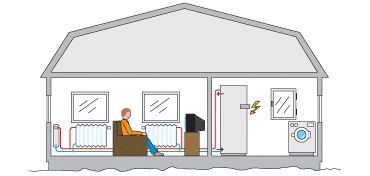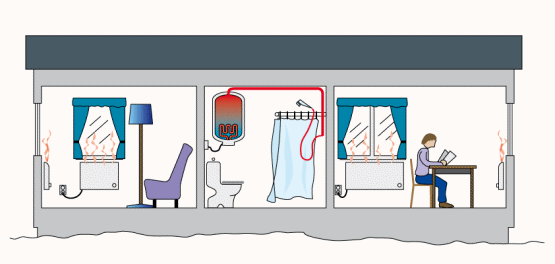Electric heating
Electricity can be used for heating buildings in two different ways – by a water-based system or a direct electric heating system.
This is how the various systems operate:
Water-based electric heating

An electric boiler or immersion heater heats the water that is pumped round a pipe system and heats a number of radiators. The water can also be circulated through coils in the floor. Illustration: Bo Reinerdahl
If you have water-based electric heating, you can install a wood-fired or pellet-fired boiler or a heat pump and connect it into the system. By installing a solar collector, you can use the sun for both warm water and space heating.
Direct electric heating

Illustration: Bo Reinerdahl
Electricity is converted directly into heat in the radiators or in coils in the floor or ceiling. Comfort underfloor heating consisting of direct-acting electricity is common in newly built houses. It is important to note that a system comprising comfort underfloor heating often leads to a higher energy consumption than if the house only has traditional radiators. Underfloor heating can easily be left switched on also in the summer to avoid a cold stone or clinker brick floor.
More efficient control system
An efficient control system for direct electric heating can save up to one tenth of the heat for electric heating of the house. Most electrically heated houses that are more than 25 years old have very poor control systems or none at all. The thermostats of the radiators are unable to maintain uniform heat, and it is difficult to maintain the required temperature in the various rooms of the house. Uniform heat improves the comfort, and a lower average temperature can be maintained than when the temperature curve has virtually uncontrolled variations.
Older radiators often have no overheating protection, which may cause scorching damage and, in the extreme, even a fire. If in doubt, get in touch with an electrician who will make a survey of the radiators and cables.
Adjust to the surroundings
An important property of the thermostats in direct electric radiators is that they quickly adjust themselves to changes in the surroundings, such as changes in solar heat or heat from a wood-fired stove. It should be possible to set the control system for direct electric radiators to a weekly programme, with daytime and night-time reductions. It should be possible to maintain different temperatures in different parts of the house.
Convert to a different form of heating
Converting from direct electric heating to some other form of heating may involve a high investment cost, but the result may be a better indoor climate and radically reduced energy costs.
If you replace the electric radiators with a water-based distribution system, you can expect the cost to be around SEK 5000 per radiator, although this may vary.
A water-based distribution system offers wide freedom of choice of heating source. If the house has a chimney breast, you can install a pellet-fired or wood-fired boiler. Heat pumps of various types are also an excellent choice, such as rock-source heat pump, ground-source heat pump or outdoor air-source heat pump.
If you decide to retain your direct electric heating, you can supplement it with, for instance, a pellet-fired stove or an air-air heat pump in order to lower the energy costs. Read more about the various heating alternatives in the menu to the left.
Read more about heat distribution and control system.
Benefits of a power monitor
You can install a power monitor in order to save electricity and thus also money. The power monitor switches off predetermined equipment, such as the heating system or water heater, when the total electricity consumption of the house reaches a certain level. This means that you can change to a lower main fuse rating and thus have a lower network charge.
Advantages and disadvantages
+ low investment cost
+ low work input
+ no local emissions
- uncertain price in the future
- some of the electricity does not come from renewable fuel
- old thermostats deliver uneven heat


